January




 Remembrance Day. Vacationed in Hawaii with Derek, Courtney and Jennifer for a week, then Maui with Gary for a week.
Remembrance Day. Vacationed in Hawaii with Derek, Courtney and Jennifer for a week, then Maui with Gary for a week.




 Remembrance Day. Vacationed in Hawaii with Derek, Courtney and Jennifer for a week, then Maui with Gary for a week.
Remembrance Day. Vacationed in Hawaii with Derek, Courtney and Jennifer for a week, then Maui with Gary for a week.
I was quite moved by this idea of individual freedom, and yet, at the same time, bothered by what I perceived to be a focus on conformity of thought in the church. Surely, God wouldn’t have made us thinking creatures to begin with if he didn’t expect us to use our minds and be individuals!
I then came across this quote from a talk by Elder Hugh B. Brown, in which he said basically the same thing as Steinbeck. “We live in an age when freedom of the mind is suppressed over much of the world. We must preserve this freedom in the Church ……… and resist all efforts of earnest men to suppress it……….”
God wants us to think freely and decide how we as individuals will apply the correct principles that we are taught. This can sometimes be a difficult thing to accept for those who want to see everything in terms of black and white, because it means that there isn’t always an easy answer to everything, and it demands that we be tolerant and accepting of the decisions of others, even if we don’t agree with them.
Another great Hugh B. Brown quote: “Just as the truths of science must be tested and verified by reason and factual investigation, so the moral and spiritual truths which the world is seeking from its prophets must be proved and validated in the experience of men. In his search for truth, every man must be true to himself. He must answer to his own reason and to his own moral conscience. Anything less than this would betray his dignity as a human being and a child of God.”

 On April 14th, 2007, my dad passed away, just four days short of his 89th birthday. Even though he lived a long, full life, I feel profound sadness at having lost one of the most influential people in my life. Losing a parent is one of those defining moments that make you pause and reflect on your own life and the meaning of it. It also makes you think about the person you loved, and what you will miss the most about them. I am fortunate to have had many years of good memories with my dad, and as a tribute to him, I would like to tell you some of the things that I loved about him and that have influenced me for good in my own life.
On April 14th, 2007, my dad passed away, just four days short of his 89th birthday. Even though he lived a long, full life, I feel profound sadness at having lost one of the most influential people in my life. Losing a parent is one of those defining moments that make you pause and reflect on your own life and the meaning of it. It also makes you think about the person you loved, and what you will miss the most about them. I am fortunate to have had many years of good memories with my dad, and as a tribute to him, I would like to tell you some of the things that I loved about him and that have influenced me for good in my own life.There were a lot of wildlife walking around the grounds here. Here's a picture of an Iguana that I took.
And a crane, I think.

Day two - Cruise begins from St. Thomas.
Here is a picture of me with our cruise ship, the Wind Star, in the background. It was a lovely ship and the crew were really friendly. We were really happy with everything, especially the great food and excellent service.

Day 3 - St. John
We took a fun excursion in the morning. It was a nature hike to the Rockefeller Resort, then we kayaked to a more secluded beach, and did some snorkeling. It was here that we ran into our first totally nude sunbathers. We were told that naked sunbathing is not allowed on St. John, but that didn't seem to matter to this middle-aged couple, who were quite friendly and kept asking us questions about our cruise. You can't see them, but they were lying right next to Gary as he snapped this picture.
 Gary got this great shot of me snorkeling!
Gary got this great shot of me snorkeling!
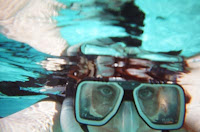
Day 4 - St. Martin/St. Maarten
Our excursion on this day was a bus tour around the Island. We got to see both the French and Dutch sides. It's amazing how different they were considering how small the island is. Here we are on the Dutch side. They have a beautiful wide beach here along a boardwalk where you can rent lounge chairs and umbrellas. We had fun here watching pelicans dive-bomb the fish alongside the dock.

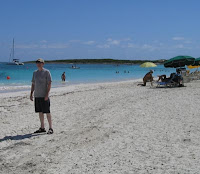
Day 5 - St. Barths
On this island, we decided to get a bit more adventurous and rent a jeep. Here's a picture of Gary, looking right at home in the driver's seat.

In the morning we stopped at one of the beautiful beaches on the island, Gouverneur Beach.
There were spectacular views here.
 We stopped at this seaside resort, called Eden Rock, to have a look around. I went into the little gift shop they had there to see if I could buy a beach towel. I found one, but the price was marked at 185 euros!! Needless to say, I went elsewhere! They did have a lovely little beach there, though.
We stopped at this seaside resort, called Eden Rock, to have a look around. I went into the little gift shop they had there to see if I could buy a beach towel. I found one, but the price was marked at 185 euros!! Needless to say, I went elsewhere! They did have a lovely little beach there, though.







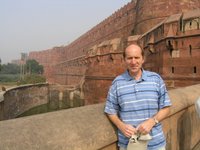
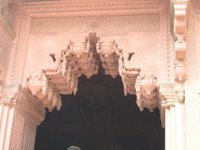

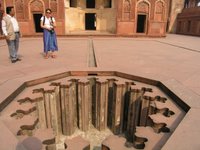
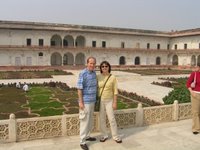

Later in the afternoon the same tour guide took us on a tour of the Taj Mahal. We entered through the main gate, which is the one that the Shah would have entered in. It is really cool to actually be there. It almost looks unreal. It is a beautiful building, built with great symmetry. I always thought that it was a mosque, but in reality it is a tomb, built by the Emporer Shah Jahan to house the body of his wife, Mumtaz, the love of his life. The theme of the building is grief, and there are quotes from the Koran written on the outside, all having to do with grief. On one side of the building, is a mosque, and on the other side is a dummy mosque, to complete the symmetry.
We had to either take off our shoes or wear booties to cover our shoes to go inside. The building is made out of marble, inlaid with precious stones. Since the marble is not porous, the dirt and grime easily wash away, so it remains looking beautiful and white, in spite of all the soot in the air. If you're interested in ready more about the history of the Taj Mahal, go to http://www.angelfire.com/in/myindia/tajmahal.html.
Here's a picture of us in front of the Taj Mahal http://www.flickr.com/photos/24435927@N00/66541860/
Later in the evening as we were getting ready to go to dinner, we heard on the news that there had been some bombings in Delhi. The bombings were at 6 pm and this was at 6:15 pm so the details were still a bit sketchy. We were worried about some of the people from our group who had left for the Delhi airport around 3:30. As the news reports continued to come in, we learned that three markets had been bombed, as well as a bus. Fortunately, everyone from our group was safe and accounted for, but we were disappointed that it would no longer be safe for us to tour the markets in Delhi the next day, something we had looked forward to. I quickly went to the shops in the hotel and bought a few more souvenirs to take home, since I had planned to do this in Delhi. In the evening we had another nice dinner with the last five people left in our group.
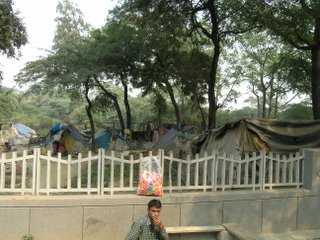
We made a pit stop about halfway on our journey at a hotel that had washrooms. Outside the hotel, there was a man and his daughter dressed up in some kind of fancy looking outfits. The man had an interesting looking musical instrument, and when we got off the bus he immediately started playing it, and the little girl started dancing for money. At first I thought it was kind of cute. But then I felt sorry for the little girl, that she had to do this instead of playing or going to school. 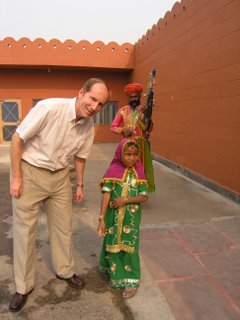
Along the highway to Agra, we saw quite a large number of small mosques. It seemed that every little town had one, and around 1 o'clock you could see all the men gather to say their prayers. With all the prayers each day, I wondered how anybody gets any work done. I found it quite fascinating to watch.
We saw a lot of agricultural activities going on as well. We would often see groups of women in the fields cutting and baling what looked liked some kind of grass. I was later told by an Indian friend that it was probably sugar cane. There seemed to be a lot more smoke in these areas too, and I guessed that they were probably burning the stubble after the cane was cut.
Another thing we noticed was that people would often just squat by the side of the road to go to the bathroom. And anywhere you would see a stone wall or fence there was usually some guy peeing on it. We joked about how in Jerusalem they have the wailing wall but in India it's the peeing wall!
The city of Agra was a bit disappointing. It was very dirty and smoky, and seemed very overcrowded. The area around the Taj Mahal seemed particularly dirty and smoky and we noticed a lot of people cooking food on open fires, which may have contributed to it. I couldn't tell what they were burning, but it smelled pretty bad. I had a sore throat for the entire time we were in Agra from breathing all the smoke. One morning I even woke up with what felt like smoker's cough.
The hotel Amarvillas in Agra was fabulous. It is such a shame that it is surrounded by so much of a contrast. It felt strange to be staying in such opulance when outside the walls of the hotel there was so much poverty. The view of the Taj Mahal from the hotel was great, but at times it was quite difficult to see it through all the haze. It was only 600 metres away, yet there were times when we could hardly see it. There is definitely something magical about being there though.
 In the evening, we had a wonderful dinner with the members of our group who were left. I think there were about 10 of us. The best part was that when we opened the menus, they had something besides Indian food. Not that we didn't like the Indian food, but it is a little hard on the stomach when you have it for every meal and are not used to all the spices. We had a fun time and some great conversation.
In the evening, we had a wonderful dinner with the members of our group who were left. I think there were about 10 of us. The best part was that when we opened the menus, they had something besides Indian food. Not that we didn't like the Indian food, but it is a little hard on the stomach when you have it for every meal and are not used to all the spices. We had a fun time and some great conversation.